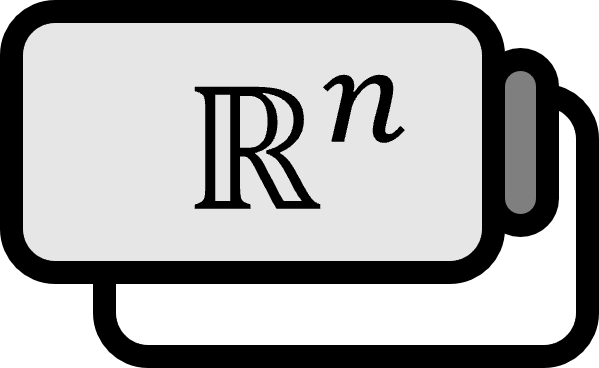Derivative of a Vector-Valued Function
Definition1
For the vector function $\mathbf{r} : I \subset \mathbb{R} \to \mathbb{R}^{3}$, if the following limit exists, then we say that $\mathbf{r}$ is differentiable at $t$ and its value is called the derivative of $\mathbf{r}$ at $t$.
$$ \dfrac{d \mathbf{r}}{d t} = \mathbf{r}^{\prime}(t) := \lim_{h \to 0} \dfrac{\mathbf{r}(t+h) - \mathbf{r}(t)}{h} $$
If for all $t \in I$ there exists $\mathbf{r}^{\prime}(t)$, then we say that $\mathbf{r}$ is differentiable at $I$. When $\mathbf{r}$ is differentiable at $I$, the $\mathbf{r}^{\prime}$ defined on $I$ is called the derivative of $\mathbf{r}$.
Explanation
This is a direct extension of the definition of the derivative for the scalar function $f : \mathbb{R} \to \mathbb{R}$.
$$ f^{\prime} (a) := \lim_{h \to 0} {{ f (a + h ) - f(a) } \over { h }} $$
In the definition, even if it is $\mathbb{R}^{n}$ instead of $\mathbb{R}^{3}$, it is defined in the same way. By the theorem below, the derivative of $m$ order is as follows.
$$ \mathbf{r}^{(m)}(t) = \left( f^{(m)}(t), g^{(m)}(t), h^{(m)}(t) \right) $$
Theorem
For a differentiable function $f_{i} : \mathbb{R} \to \mathbb{R}$, if $\mathbf{r}(t) = \left( f_{1}(t), \dots, f_{n}(t) \right)$, then
$$ \mathbf{r}^{\prime}(t) = \left( f_{1}^{\prime}(t), \dots, f_{n}^{\prime}(t) \right) $$
Proof
It can be shown by simple calculation. By the definition of limit,
$$ \begin{align*} \mathbf{r}^{\prime}(t) &= \lim_{h \to 0} \dfrac{\mathbf{r}(t+h) - \mathbf{r}(t)}{h} \\ &= \lim_{h \to 0} \dfrac{(f_{1}(t+h), \dots, f_{n}(t+h)) - (f(t), \dots, f_{n}(t))}{h} \\ &= \lim_{h \to 0} \left( \dfrac{f_{1}(t+h) - f_{1}(t)}{h}, \dots, \dfrac{f_{n}(t+h) - f_{n}(t)}{h} \right) \\ &= \left( \lim_{h \to 0}\dfrac{f_{1}(t+h) - f_{1}(t)}{h}, \dots, \lim_{h \to 0}\dfrac{f_{n}(t+h) - f_{n}(t)}{h} \right) \\ &= \left( f_{1}^{\prime}(t), \dots, f_{n}^{\prime}(t) \right) \end{align*} $$
Properties
For two vector functions $\mathbf{u}, \mathbf{v} : \mathbb{R} \to \mathbb{R}^{n}$ and scalar function $f : \mathbb{R} \to \mathbb{R}$, and constant $c \in \mathbb{R}$, the following hold.
1. Linearity: $\dfrac{d}{dt} [\mathbf{u}(t) \pm \mathbf{v}(t)] = \mathbf{u}^{\prime}(t) \pm \mathbf{v}^{\prime}(t)$
2. Linearity: $\dfrac{d}{dt} [c \mathbf{u}(t)] = c \mathbf{u}^{\prime}(t)$
3. Product Rule: $\dfrac{d}{dt} [f(t) \mathbf{u}(t)] = f^{\prime}(t) \mathbf{u}(t) + f(t) \mathbf{u}^{\prime}(t)$
4. Differentiation of the Inner Product: $\dfrac{d}{dt} [\mathbf{u}(t) \cdot \mathbf{v}(t)] = \mathbf{u}^{\prime}(t) \cdot \mathbf{v}(t) + \mathbf{u}(t) \cdot \mathbf{v}^{\prime}(t)$
5. Differentiation of the Cross Product: $\dfrac{d}{dt} [\mathbf{u}(t) \times \mathbf{v}(t)] = \mathbf{u}^{\prime}(t) \times \mathbf{v}(t) + \mathbf{u}(t) \times \mathbf{v}^{\prime}(t)$
6. Chain Rule: $\dfrac{d}{dt} [\mathbf{u}(f(t))] = \mathbf{u}^{\prime}(f(t)) f^{\prime}(t)$
James Stewart, Daniel Clegg, and Saleem Watson, Calculus (early transcendentals, 9E), p898-899 ↩︎
